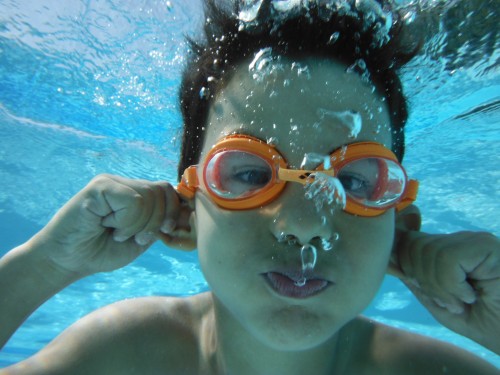How to learn to swim at home
For children who are safe and comfortable in the water. Swimming lessons adapted to your child's level.
Learn to swim at home with a sports coach
Your child's progress will be smooth and at his/her own pace.
Being at home allows your child to be reassured and to confide in you more easily about any doubts or fears.
A familiar place for your child, a pool that fits your child
For your child it is a familiar and reassuring environment. The space and the pool are smaller than in a municipal pool. Your child knows the place.
Being in your home, the coach will be able to progress at your child's pace and, above all, you will be able to see the child's progress.
You will have access to the coach for all your requests, questions and doubts.
Going to a public swimming pool for a swimming lesson can be a source of stress for your child.
It is an open space with a much larger pool than yours and probably deeper.
There are many more people, noise and screams in an unfamiliar environment.
All of this means that your child may have some reservations.
His toys, equipment and lifeguard
The fact of being at home in a familiar environment, with his games and toys, his swimming equipment (goggles, fries) means that he will be reassured straight away.
Knowing the pool and the area will give him more confidence.
All these elements facilitate the relationship and the bond that is created between the sports coach and your child.
Your child will feel really unique, as all the advice and attention will be for them and in their own home.
We can lend the swimming goggles. Having their own can motivate them to wear them more easily and allows them to continue to progress between sessions.
We bring all the other necessary equipment (teaching material, chips, toys, mats,
etc).
Please contact us on 076 634 22 31 if you would like to purchase any other fun and educational material for your child to use outside the sessions.
How does a private swimming lesson work?
Ideal teaching conditions for happy fish
Do you want the best conditions for your child to learn to swim?
Every child has a different relationship with water, depending on his or her history and first contact with water.
Teaching your child to swim requires a lot of experience and distance.
Give us your trust, more than 120 families have been doing it every summer for the last 5 years.
Many of you want to see your child kicking and twisting. Don't be fooled by appearances, this is not SWIMMING, "lifeguarding" is a real job.
In the water, the differences in levels and progress can be very marked and are a direct echo of the various experiences (positive or negative) that children have had in the past (emotional relationship with water).
Some will reach autonomy before they are 4 years old while others will have to work hard until they are 7 years old... Take this into account and don't put pressure on your children, on the contrary, give them confidence by getting them used to splashing water on their face and other family games in the bath.
Congratulate them!
Educational framework
Presence of parent not compulsory, or even discouraged (except for babies); if present, then no intervention, even to encourage.
The presence of a relative can sometimes reduce the child's concentration and remove him/her from our "authority".
We want to create an "exclusive" relationship of trust with the little ones and keep the child's full attention during the swimming lesson for optimal learning quality.
No swimming before the session (maintains energy, excitement, attention).
Avoid the presence of other children around and in the pool (= source of distraction).
Prepare a basket of tasty, juicy fruit for the outing. Impressive caloric expenditure.
impressive.
And a snack is MANDATORY less than 45 minutes before the lesson. Fruit will be your best ally because it has a high glycemic index, which means that it will provide the fuel and energy you need immediately. Moreover, fruit is easy to digest, so all your child's energy and attention will be directed to the exercises to be performed.
Wrapping the child up when they get out of the water by drying their hair and ears straight away will also help.
Stages of development and learning
From discovery to improvement:
- Baby swimmer from 6 months to 3 years: familiarisation, awakening and development of primary reflexes.
- Water garden from 3 years to 6 years: consolidation of the golden triangle - immersion, propulsion,
balance - in the form of a playful course.
- Improvement from 6 years to 13 years: learning the four strokes
Objectives :
- to be at ease in the water
- discover the aquatic environment
- learn to float, move, go underwater, jump into the water
- know how to get out of the water in case of a fall
- learn the basics of swimming
- learn the techniques of the 4 strokes
Tips and tricks for faster progress when the swimming teacher is not there.
The Frite is the best teaching material, no passive floating but active with the arms free and in contact with the environment ... You can first pedal vertically and then tap your legs (flapping) while lying on your stomach or back. Parents Remain vigilant.
Never give too direct/violent warnings, e.g. "Be careful, it's very dangerous, you'll drown": Use positive words. As long as they can't swim, your child is your responsibility. By using too many warnings or negative language, you could traumatise (irrational fear like phobia) and slow down his progress... it is your responsibility to keep him in sight. His safety is your responsibility, not his
Do not teach head-up breaststroke, aquatic equilibrium is a horizontal equilibrium, (only respecting the natural vertebral alignment guarantees the body's buoyancy). Your child should put his or her face in the water from the very first lesson, as this helps to demystify the environment and build confidence. We are never afraid of what we see, but of what we don't see (imaginary, sharks...) hence the games in the baths, the splashes, the water projections on the face, opening the eyes in the water, identifying shapes and colours.
Learn to blow into the water with your mouth closed to make bubbles... this is how your child will best start learning, soon he will be ready to handle any situation.
Outside of lessons, don't play lifeguard, it's a job, just play with them to maintain contact with the water in soft, playful conditions. Play without goals.
Make bubbles with your mouth closed in the bath or with a straw in a glass... You never hold air when swimming, you blow in the water all the time...
All the "peritraining" work, splashing in the shower, creates a positive and supportive emotional environment.
You can also find swimming lessons in our partner pools
https://bain-bleu.ch
https://ecolenatationthonex.ch

